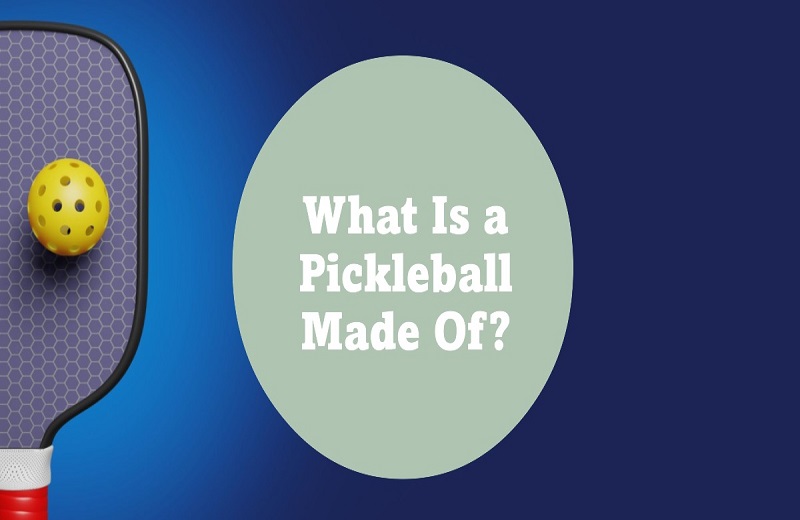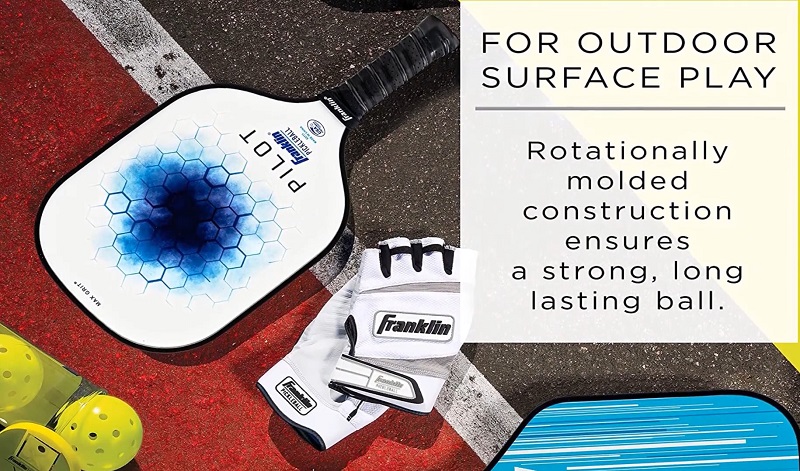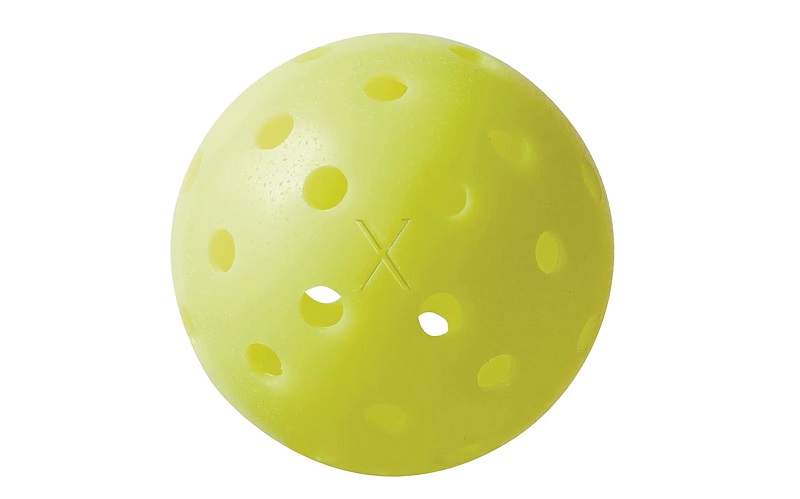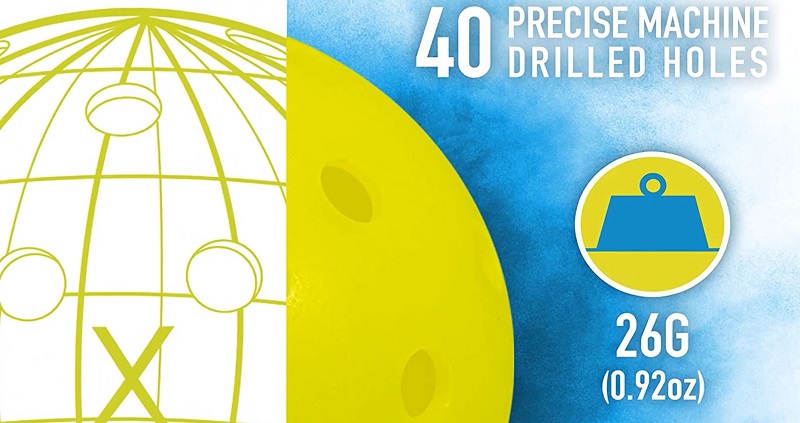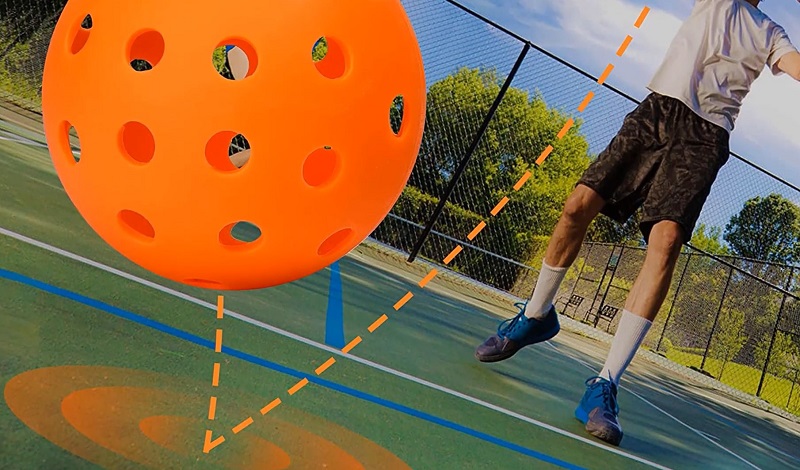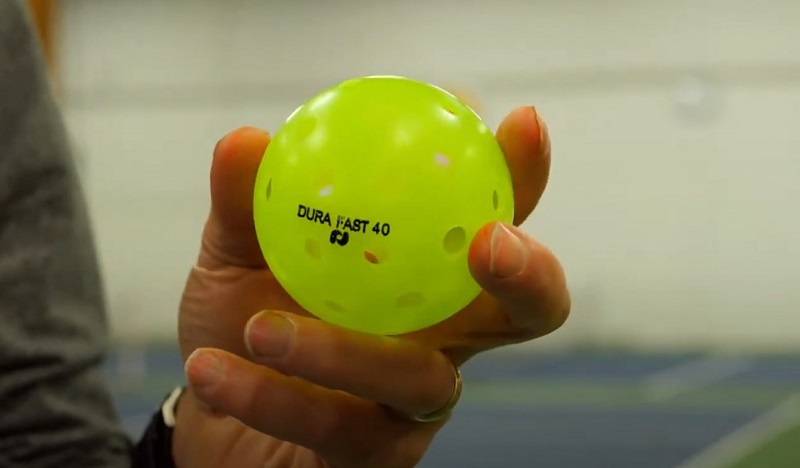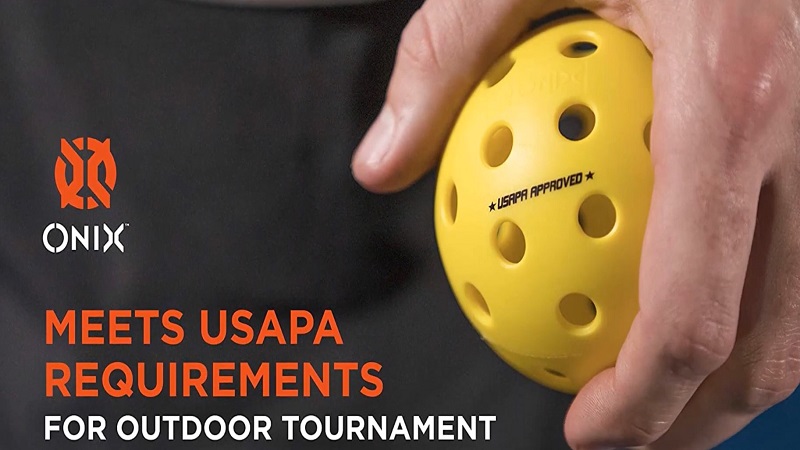What is a Pickleball Made of? Material Composition of a Pickleball
Pickleballs are typically made from hard plastics, resins, or polymers, with their hardness and construction varying based on whether they’re intended for indoor or outdoor use. Indoor pickleballs are often made from softer plastics, smooth plastic, allowing for easier control but less distance and speed. Outdoor pickleballs, on the other hand, are made from harder, heavier plastics, providing more power and resistance to wind and impact. The material used significantly impacts the playability of the game. Specific types of plastics used in pickleball manufacturing include Low-Density Polyethylene (LDPE) and High-Density Polyethylene (HDPE).
Indoor Pickleballs
Unique Characteristics
Indoor pickleballs are designed with unique characteristics to suit indoor court surfaces. They are made of a lighter plastic, which is more adaptable to smoother surfaces like wooden gym floors.
Weight, Size, and Hole Count
The weight of an indoor pickleball is approximately 0.8 ounces (22.68 grams), and they typically have 26 holes. Indoor pickleball made of lightweight composite materials makes it more challenging to generate power with each pass, resulting in longer volleys between players.
Impact of Temperature
The temperature of the indoor environment can also affect the playability of the pickleball. For instance, the softer material of indoor pickleballs compresses more when struck with the paddle.
Variations Among Brands
Different brands may have slight variations in the hardness of their indoor pickleballs, with some brands producing slightly softer balls than others.
Performance Characteristics
The performance characteristics of indoor pickleball balls are designed to maximize and complement the indoor play. However, the lack of power is considered a drawback for many experienced pickleball players.
Outdoor Pickleballs
Unique Characteristics
Outdoor pickleball, on the other hand, are made of a harder, more durable plastic to withstand the rougher surfaces and weather conditions of outdoor courts. Outdoor balls are typically made using injection-molded or rotocast techniques, ensuring optimal durability and performance on the court.
Weight, Size, and Hole Count
They weigh about 0.9 ounces (25.51 grams), making them slightly heavier than indoor pickleballs. This slight difference in weight can significantly change the game, allowing players to have more power behind their hits. Outdoor pickleballs also have more holes, about 40 compared to the indoor ball’s 26 holes.
Impact of Temperature
The effect of temperature on the playability of outdoor pickleballs is also notable. For instance, the ball’s playability characteristics can change distinctly between morning and afternoon play due to temperature variations.
Performance Characteristics
In terms of performance characteristics, outdoor pickleballs are less commonly used on indoor courts as they don’t perform well on softer surfaces. They also tend to crack more frequently than indoor balls due to exposure to rough surfaces and elements.
Special Types of Ball
Foam Pickleballs and Their Use Cases
In my experience, foam pickleballs are a unique alternative to traditional plastic balls. They’re typically used for casual play or practice, especially indoors, due to their softer and quieter nature. However, they’re not approved by the USA Pickleball Association for official tournaments.
Noise Reduction Benefits of Foam Pickleballs
One of the main reasons I love foam pickleballs is their noise reduction benefits. They’re significantly quieter than their plastic counterparts, making them ideal for indoor play in gyms or residential areas where noise can be a concern.
Limitations of Foam Pickleballs in Official Tournaments
Despite their benefits, foam pickleballs have their limitations. They’re not allowed in official tournaments due to their lighter weight and different play characteristics compared to standard pickleball ball.
Non-Standard Materials in Pickleballs
While most pickleballs are made of hard plastic or thermoplastic resin, there are variations in materials used for special circumstances or non-official play. For instance, some indoor balls are made of tough, smooth foam.
Regulation and Standards for Pickleballs
Regulations by the International Federation of Pickleball and USA Pickleball
The International Federation of Pickleball and USA Pickleball has set specific regulations for pickleballs. These rules cover aspects like the ball’s material, size, weight, and the number and shape of its hole. For more details, Section 2.D IPF & USAP 2023 Rulebook states that:
2.D. Ball Specifications.
2.D.1. Design. The ball shall have a minimum of 26 to a maximumof 40 circular holes, with spacing of the holes and overall design of the ball conforming to flight characteristics. The ball must have a manufacturer’s or supplier’s name or logo printed or embossed on the surface.
2.D.2. Approval. The Tournament Director will choose the tournament ball. The ball selected for play in any USA PICKLEBALL or IFP sanctioned tournament must be named on the official list of approved balls posted on the USA PICKLEBALL and IFP websites.
2.D.3. Construction. The ball shall be made of a durable material molded with a smooth surface and free of texturing. The ball will be one uniform color, except for identification markings. The ball may have a slight ridge at the seam, as long as it does not significantly impact the ball’s flight characteristics.
Requirements for a Tournament-Approved Pickleball
For a pickleball to be tournament-approved, it must meet certain specifications. It should be made of a durable material with a smooth surface, have between 26 and 40 evenly spaced holes, and meet specific weight and size requirements.
Role of Hardness, Weight, and Size
The hardness, weight, and size of a pickleball play a crucial role in meeting tournament requirements. The ball must maintain its round shape, be able to bounce, and fall within a specific weight and size range.
Regulations Regarding Holes, Bounce Height, and “Out of Round” Variance
Specific regulations also cover the number and shape of the holes in a pickleball, the bounce height, and the “out of round” variance. For instance, the ball must bounce between 30 and 34 inches high when dropped from a height of 78 inches.
Evolution of Pickleball Regulations and Standards
Over the years, the regulations and standards for pickleballs have evolved. Initially, players used a Cosom ball for both indoor and outdoor play. However, with the development of the International Federation of Pickleball and USA Pickleball, equipment regulations have been established, leading to the creation of different pickleballs for indoor and outdoor use.
Popular Pickleball Manufacturers
When it comes to pickleball manufacturers, two names that often come up are Wilson Sporting Goods and ONIX. Both of these brands have made significant contributions to the sport, offering high-quality pickleballs that are loved by players worldwide.
Wilson Sporting Goods
Wilson Sporting Goods is a well-known brand in the sports industry, and their entry into the pickleball market has been nothing short of impressive. Their TRU 32 ball, for instance, is a popular choice among players. It’s made using a mold and thermoplastic resin, with 32 evenly spaced holes giving it a unique flight characteristic.
ONIX
ONIX, on the other hand, is a brand that’s well-known among pickleball enthusiasts. They produce one of the most commonly used balls in pickleball tournaments, the ONIX DURA Fast 40. This ball, named after the number of holes punched into the plastic ball after production, is one of the highest quality balls available to pickleball players.
Manufacturing Process
The process of making a pickleball is quite fascinating. It typically involves injecting a single heated piece of plastic or a thermoplastic resin into a mold. The mold is then rotated to form the rounded shape of the ball. Many outdoor pickleballs don’t have a seam, but a slight seam ridge is permitted, provided it does not affect the ball’s flight characteristics.
Innovations in Manufacturing
In recent years, there have been some innovations in the manufacturing process of pickleballs. For instance, some manufacturers have started using Low-Density Polyethylene or LDPE, a type of plastic that falls into Plastics Category 4 for recycling purposes. This not only makes the balls more durable but also more environmentally friendly.
Environmental Impact
Pickleballs are typically made of hard plastics, resins, or polymers, which raises questions about their environmental impact. One type of plastic often used is Low-Density Polyethylene (LDPE), which falls into Plastics Category 4 for recycling purposes. However, not all plastics are suitable for making pickleballs, and manufacturers often have trade secrets regarding the materials they use.
Sustainability Practices of Pickleball Manufacturers
While the exact sustainability practices of pickleball manufacturers are not widely disclosed, it’s important to note that the manufacturing process involves injecting a single heated piece of plastic or a thermoplastic resin into a mold. This process could potentially be optimized for greater sustainability. However, more transparency from manufacturers is needed to fully assess their environmental impact.
Impact of Material on Gameplay
The material of a pickleball significantly affects its playability. For instance, balls made of softer materials are easier to control but don’t travel as far or as fast as balls made with harder ones.
Indoor vs Outdoor Pickleballs
Indoor pickleballs are made of softer plastic and are lighter with larger holes, making them easier to control but harder to hit with power. Outdoor pickleballs, on the other hand, are made of heavier, harder plastic and are more resistant to wind and impact. These differences in material and design can significantly affect player strategies and preferences. To learn more about the differences between indoor and outdoor pickleballs Click here
Are pickle balls recyclable?
What’s the difference between indoor pickle balls and outdoor pickle balls?
How often should pickleballs be replaced?
What is the difference between orange and yellow pickleballs?
Related Articles:

